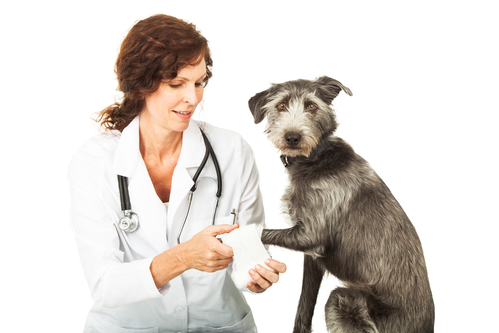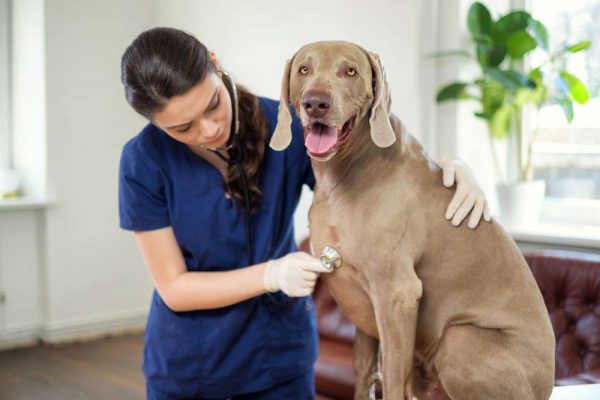You’ll do almost anything to get help for your dog in pain!
However, pain relief for dogs can be tricky. Just like people, dogs do feel pain. But, unlike people, dogs don’t have a good way to tell you what hurts or even that something does hurt!
In addition, recognizing pain in your dog can be difficult because animals do not act the way we do, when they are in pain. Because of this, vets used to think that dogs did not feel pain.
Unbelievable to us, veterinarians did routine surgeries like spaying and neutering, without pain relief for dogs.
Today, we know that dogs do feel pain, and vets routinely prescribe pain medications for pain relief.

Pain in dogs is not limited to seniors with terminal illnesses like cancer. A dog of any age can get hurt or ill and can be feeling pain. That’s why it is so important to know your dog well and observe any changes in her behavior.
This article includes:
- What are the Symptoms of Dog Pain?
- Do You Have a Dog in Chronic Pain?
- Is Your Dog Hiding His Pain?
- Could Your Dog be Faking Pain?
- Types of Pain in Dogs
- Pain Relief for Dogs – What Your Vet Can Do
- Things You Can Do to Help your Dog in Pain
What are the Symptoms of Dog Pain?
Dogs are living longer than they used to, just as people are. As a result, we are seeing more aches and pains in senior dogs.
Because dogs show pain differently than we do, we need to tune into their ways they communicate to us that they are hurting.
Here are some common symptoms of acute pain in dogs:
- Acting aggressively – Just like a grumpy old man or woman, your dog may feel and act grumpy when she hurts somewhere.
- Crying out when touched – Your dog may actually make a whining or crying sound when you touch an area on her body that hurts. This is a good indicator that a body part or limb hurts.
- Constant barking or whining – If your dog does this, and it is not characteristic for him, consider that there may be a physical issue.
- Pacing or restlessness – If your dog is restless, she may be having trouble getting comfortable or relaxing, because something hurts.
- Licking, chewing or scratching – This is typically done to a sore area, the sight of surgical stitches, an infected scratch or wound or something else that is bothering your dog.
- Trembling – especially if this is unusual for your dog.
- Panting or rapid breathing – when your dog is not hot.
- Increased heart rate and elevated temperature
- Lying down in a different position – Your dog changes position frequently as if she can’t get comfortable or she lies in a position not normal for her.
- Unable to sleep – Your dog wakes you at night because he cannot sleep. Or, he tosses and turns all night, unable to get comfortable and relaxed.
- Dilated pupils
Do You Have a Dog in Chronic Pain?
Chronic pain is more difficult to detect. Usually pain develops over a period of time and your dog does not show any sudden symptoms of pain.
The signs of chronic pain look similar to many other conditions, so if your dog has these symptoms, it does not necessarily mean that she is in pain.
You need to look at the bigger picture, observing your dog’s interactions with family members. In addition, watch for:
- Lack of activity – lying around when your dog is normally active and energetic
- Decreased appetite – not eating well
- Weight loss
- Not grooming himself
Also, if you give your dog something for pain relief and he perks up with more energy and animation, it could mean that he has been suffering with pain. The pain medication made him feel better.
Is Your Dog Hiding His Pain?
Dogs do not always express pain and suffering like other dogs. They are individuals, just like people.
An example of this is that, dogs in pain often greet friends and relatives enthusiastically, showing no signs of pain. It’s almost as if, for the moment, your dog has forgotten that he hurts.
On another note, if a dog does not show that he is in pain, he may have learned this behavior.
For example, a hunting dog like a Weimaraner or a retriever can learn to ignore scratches and cuts when she is hunting for birds or rabbits in a field of brush. The excitement of flushing birds on the hunt, itself becomes more important to the dog than how she feels.
A springer spaniel charging through sticker bushes to flush out a bird doesn’t mind or even notice that he is being cut by sharp thorns. However, a more sensitive dog breed would be reluctant to run through the prickly brush.
Your dog’s breeding has an influence on whether or not she lets others know she is in pain. Just like a red coat was bred into the Irish setter breed, some hunting dogs were bred to be more courageous and more daring in uncomfortable situations. And bred to simply ignore pain during a hunt.
Could Your Dog be Faking Pain?
While most dogs don’t just fake pain, it does happen sometimes.
Remember how dogs learn? They observe that when one thing happens another occurs. When A occurs, then B happens. For example, when I go outside to do my business, I get a treat.
So, if your dog was sick or hurt when she was younger, she found that she got lots of attention and perhaps treats. Every time she did a certain thing, like limp, the result was predictable (and fun or nice).
Given that dogs can learn fast, some dogs pick up on this and repeat the behaviors that gave them the results they liked. In other words, they learn to fake pain or injury to get treats or attention.
Does this happen often? Not real often. But at least you know it could be an issue for your dog if he has been hurt or sick before.
Types of Pain in Dogs
Dogs have pain for different reasons. In aging dogs, the most common cause of pain is osteoarthritis.
Acute pain in dogs
This is the pain that you would be most likely to notice. Your dog will have acute pain if she has an injury like a bruise or cut, a broken bone, a sprained or strained muscle.
Acute pain is felt in people as sharp, throbbing, aching or burning pain. Acute pain usually improves about 3 days after the event that caused it. Sometimes, though, it can last for weeks or even months.
Chronic pain
This is pain that lasts for longer than the expected time for healing, or pain that is associated with a non-cancerous disease like arthritis, that will probably continue to get worse.
Cancer pain
Pain from cancer is caused by a tumor growing, spread of the cancer, or by the the side effects of chemotherapy or radiation treatments. Cancer pain is often intense.
Nerve pain
Your dog will feel this kind of pain when he has had damage to a nerve or to some part of his central nervous system, including his spine. This one is sometimes overlooked by veterinarians, because it is really hard to diagnose.
Pain Relief for Dogs
What Your Vet Can Do
Your vet will decide on how to give your dog pain relief, based on how much pain your dog is in, her overall health, and how long your pet’s pain is expected to last.

Medications that are often prescribed include:
- NSAIDS (Nonsteroidal anti-inflammatory drugs) – Should be taken on a full stomach. This family of drugs includes Ibuprofen and aspirin. NSAIDS can be hard on your dog’s stomach and sometimes the liver and the kidneys. If your dog has a reaction, he could have symptoms like poor appetite, vomiting, diarrhea and eventually weakness and disinterest in people and activities your dog enjoys. If your dog is taking NSAIDS and shows any of these symptoms, take him off the NSAIDS and talk to your vet. There have been canine deaths associated with NSAIDS.
- Adequan – This is an injection that blocks enzymes that cause inflammation and injury joint cartilage. Given for arthritis in dogs.
- Fentanyl skin patches – for serious pain. Sometimes used for dogs with cancer. This is a controlled substance, so store it carefully. Overdoses can cause sleep and possible respiratory arrest.
- Rimadyl – Used for osteoarthritis and other inflammatory pain. If this is prescribed, your dog will need to have routine blood tests to assess her liver and kidney functions. Rimadyl can have the same side effects as other NSAIDS.
Dog Pain Relief
Things You Can Do to Help
Stress is another factor in pain control. Reducing your pet’s stress level and keeping him comfortable but away from over-stimulaton, will help your dog feel more calm and relaxed. And she will feel less pain, as a result.
Managing your dog when he is under stress and pain will require a calm and quiet location for your dog, good nursing care (heat, cold packs, bandages, etc.) and perhaps physical therapy and medications.
- Supplements – Fortunately there are a number of natural supplements that do help relieve dogs in pain.
- ActivFlex – Glucosamine and Chondroitin
- Omega 3 Krill Oil
- Turmeric – works for people, too.
- Hemp Oil – for pain and mobility.
- Weight control – keeping your dog at a healthy weight will help lessen the stress on painful joints.
- Moderate exercise – keeps your dog healthy and muscles stronger. Just make sure your dog doesn’t overdo.
- Extra padding or bedding – You can pad your dog’s sleeping area with throw rugs, towels or blankets.
- Orthopedic bed – An orthopedic bed will help support joints and muscles.
- Warmth during cold and damp weather – a pet heating pad works nicely.
- Acupuncture – has been used successfully with dogs for pain relief.
- Massage – always feels good when you are under the weather!
- Avoid causing pain – If your Weimaraner acts like it hurts when you touch or handle her, do handle her carefully and avoid rough play.
Good pain management for dogs can help your dog recover from illness faster or help her get through a tough time with illness as she ages.






Leave a Reply